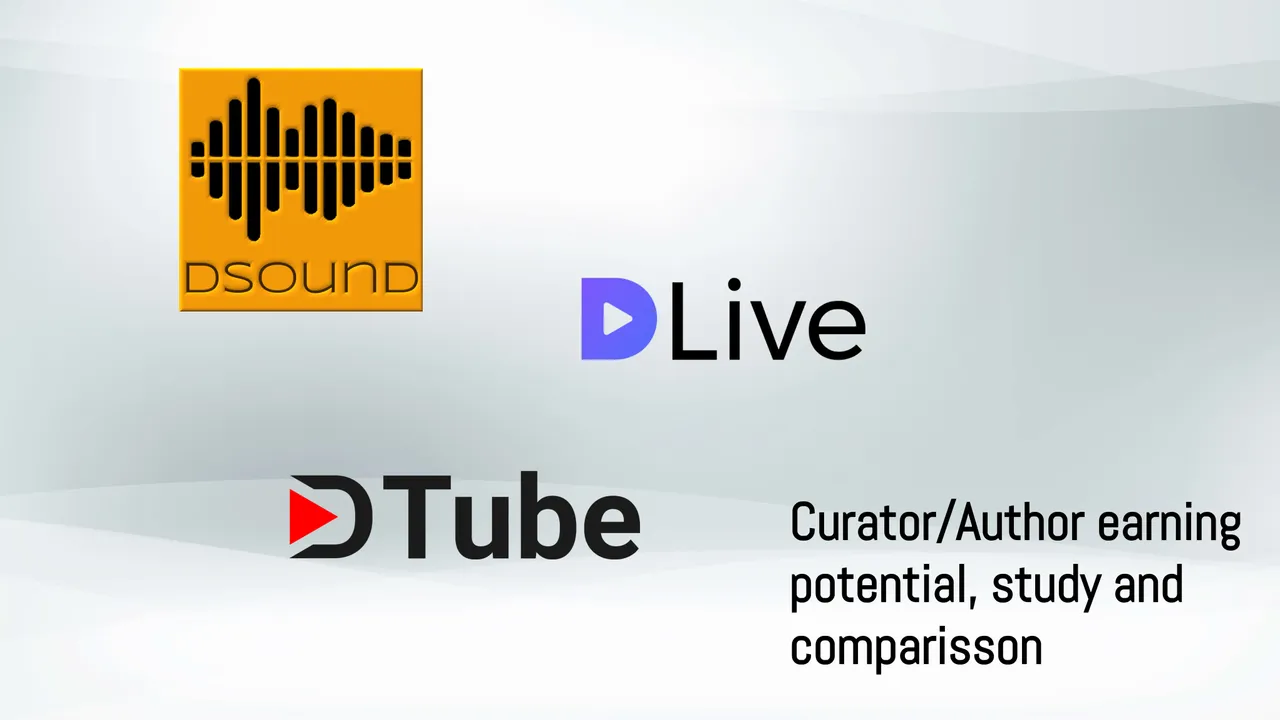
#Repositories
Steem: https://github.com/steemit/steem
DTube: https://github.com/dtube/dtube
DSound: https://github.com/dsound/dsound
DLive: https://dlive.io/ (no github)
Before starting the post I want to thank @eonwarped for helping me make this post. Without his help I most definetly wouldn’t be able to pull this off. He basically did the hard work since I have no skill in using SteemSQL. He collected all the stats we needed and triple checked the calculations, re-did queries as many times as was needed and went back more times than I can count to pull up some more.
So thx Eon for helping out when i came to you with this idea. #helpie
On to the post….
CONTENTS
GENERAL
DATA COLLECTION BASICS
DTUBE DATA
DLIVE DATA
DSOUND DATA
COMPARISON TABLE
CONCLUSION
1. GENERAL
Few weeks back there was a post by @kevinwong (Etherpunk) i read, about his troubles with the curation system and his idea of increasing curation to 50%.. I wont be discussing his idea here, but he also mentioned a few numbers. His curation rewards and his ROI on the investment in Steem.
Post link: https://steemit.com/steem/@kevinwong/amazing-profit-potential-here-s-how-to-earn-a-whopping-usd2-000-per-year-by-locking-up-usd250-000
So that made me think.
If i pulled some stats from the blockchain and put it all on paper, would it be possible to at least come close to discerning what the earning potential for curators and authors would be on various platforms?
Some investors really arent happy with their ROI, which is part of the reason why they resort to delegating to bots, or self-upvote, so i wanted to see what ROI they could potentially have if they take absolute (this of course isnt possible, but an improvement can be made) advantage of the opportunities offered. At the same time authors, that are interested in audio/video content creation, as well would probably want to know what their earning potential would be and in that regard compare the dapps at their disposal (audio/video).
Instead of focusing on only one aspect curator or author; or one platform (which could have made for maybe 5-6 posts, we decided to accumulate all the data with the calculations completed into this one post.
In this post we will be taking the 3 Steem platforms: 1. Dtube, 2. Dlive, 3. Dsound
and looking at the earning potential for authors and curators. We take into account, the upvotes given by each of the platforms, effect of those upvotes on curation, their beneficiary fees, their upvote rates, their upvote weight, and upvote distribution. All of this would hopefully show us, from a purely monetary perspective (the monetary aspect of course isnt the only thing that affects decision on using a platform) what platform is the best in that regard for authors and curators.
Our goals are to show that it is possible to reach a much higher ROI than curators are currently achieving by supporting quality creators (or creators perceived as quality by curation teams) on these platforms and to give an answer to authors as to what kind of earning potential they can have on each of these platforms. (New user and established)
2. DATA COLLECTION
Data collection took quite a bit of time since there is more then 1 subject being analysed from multiple angles along with various calculations that took place to provide us with the stats we needed.
Since taking into account all the different SP invested by each curator, or the percentages they use to upvote content is a extremely complex task, we have set the effective curator SP at 100k SP. This is a nice round number and hopefully it wont be hard for curators to decipher where they stand.
Since our goal should be to promote quality content, we assumed the dtube/dlive/dsound curation team goal is the same as well, so all the curation stats are adjusted towards posts that are upvoted by the platform (dtube/dlive/dsound) in question, before the platform has cast its vote. consensus on quality/value.
Important to mention is the 25% beneficiary fees that go to Dtube/Dsound, while Dlive has no beneficiary fees. The beneficiary fees of Dtube are redistributed back to curators (dtube does not keep its beneficiary fees as a voter) while Dsound keeps the 25% beneficiary fees for development. (rshares)
Dsound and dlive upvote frequently with low % while Dtube upvotes with low % less frequently. (important to mention for upvote chance stat).
Dsound, which will be seen in the stats also has fewer monthly uploads to platform then dtube/dlive which are much closer in number.
Also Dsound SP is around 50% of dtube/dlive.
The author stats also assume no self upvote by the author. The platform curation assumes no curator votes before platform upvote cast.
Curation data assumes 10 upvotes per day at 100% upvote weight.
We will be using 3 tables for each platform.
- Shows stats for "new" user based on upvote chance of platform, average upvote value of the platform. Showing what it would look like starting up.
- Projected earnings for established, perceived as quality authors, by the platforms curation team. (without curator upvote)
- Projected earnings for the curator, assuming upvote prior to platform upvote at 100% for 100k SP. Annual ROI, earnings from beneficiary fees (if Dtube) and curation.
3. DTUBE DATA
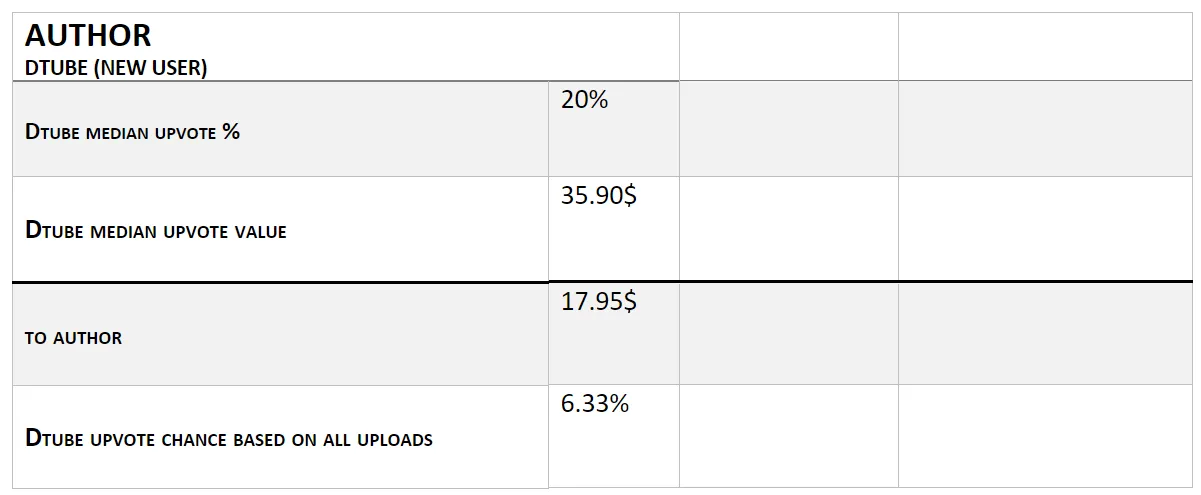


4.DLIVE DATA
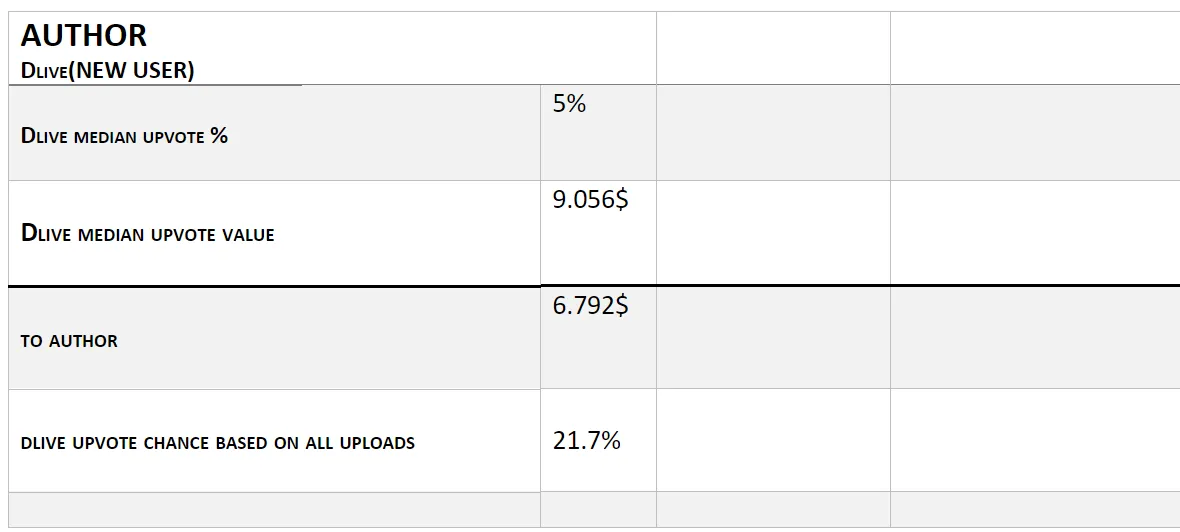
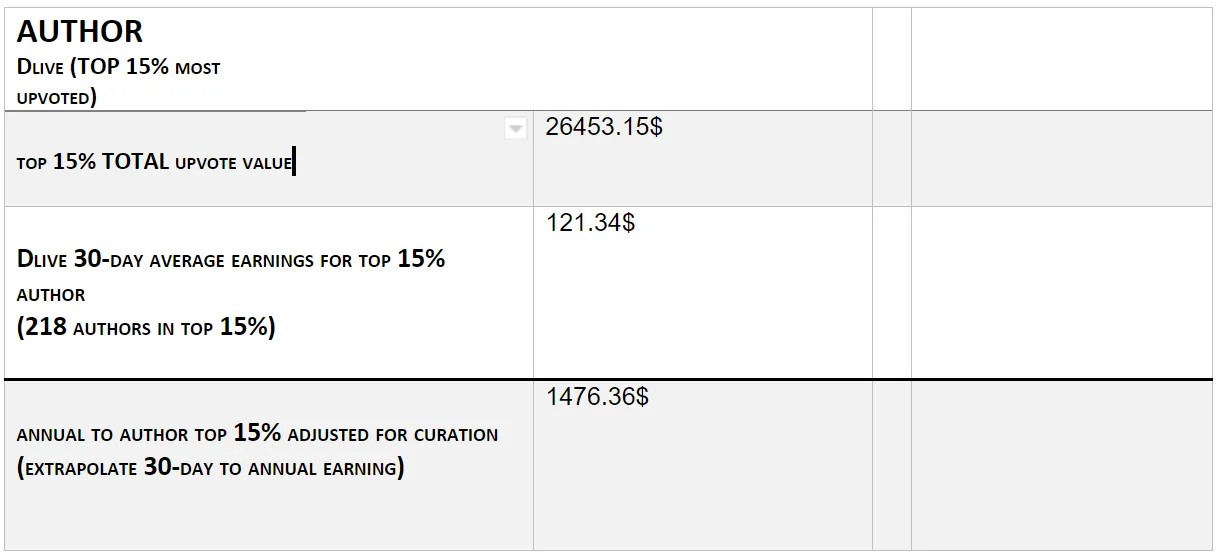
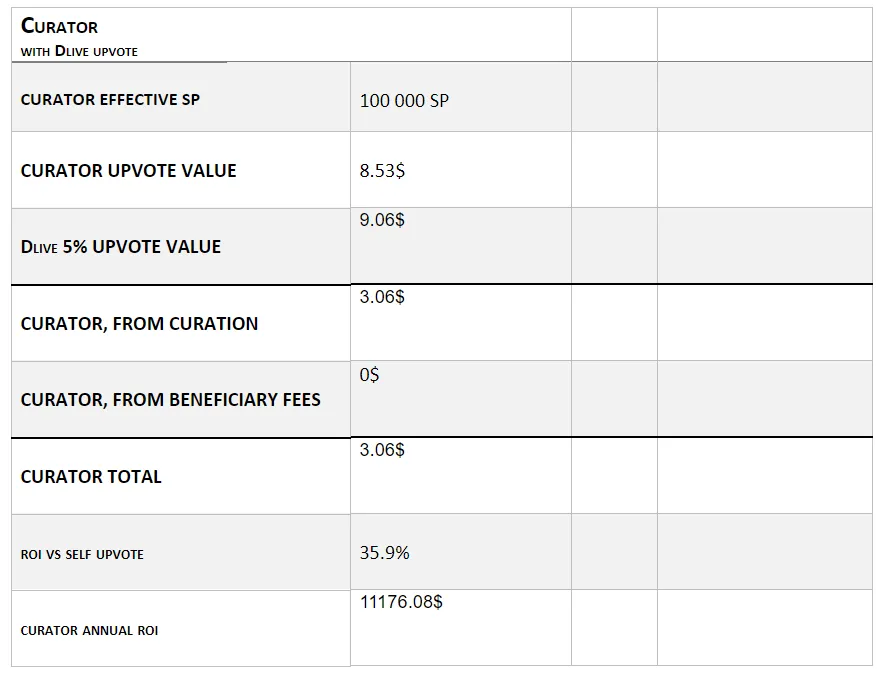
5.DSOUND DATA
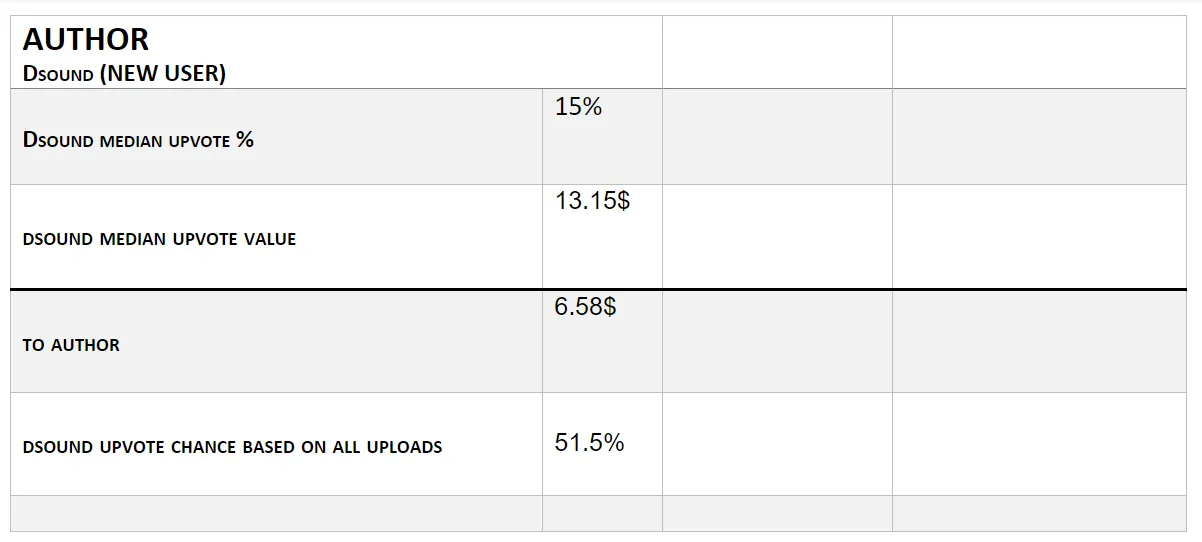
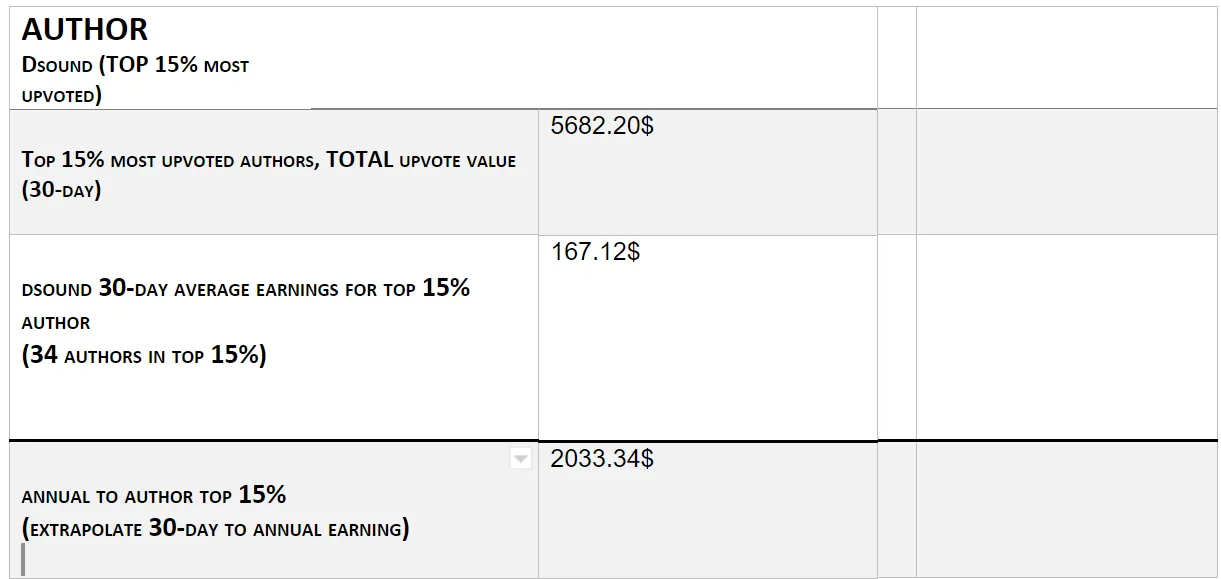
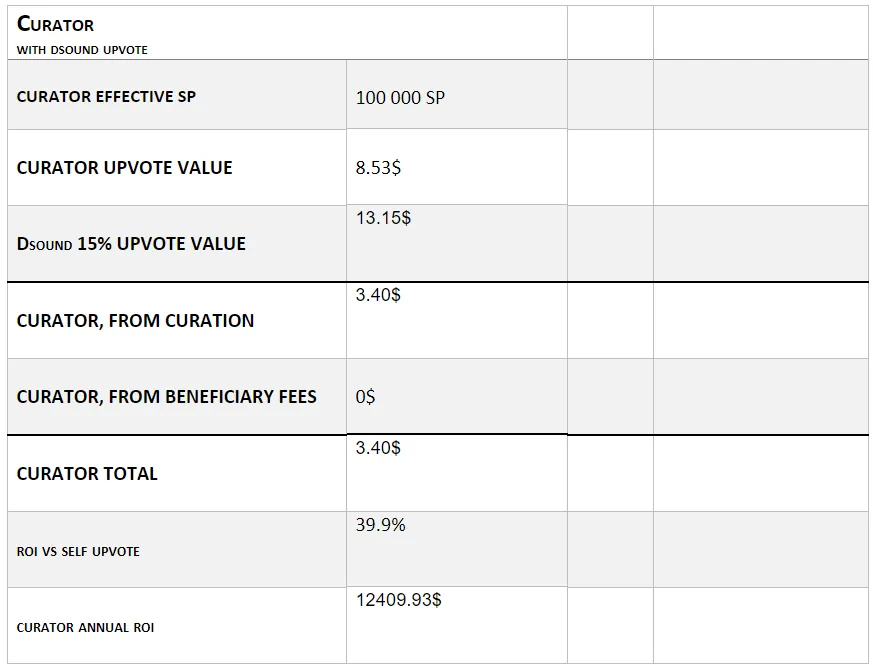
6. COMPARISON TABLE
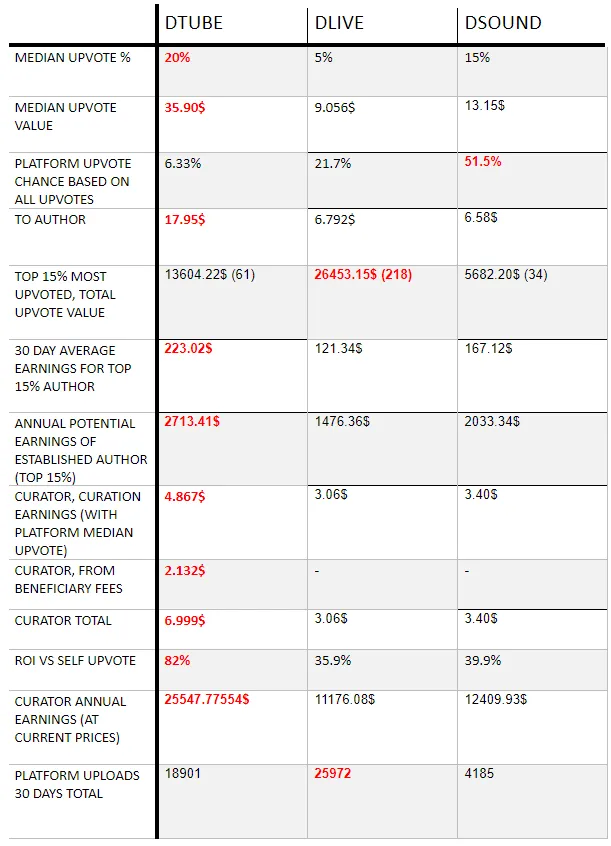

7. CONCLUSION
It is clear that each platforms offers advantages in its own area.
Dtube offers highest earning potential to authors with highest perceived quality (by respective curation teams) then the other 2 in monetary gain, and due to higher median upvote values its unrivaled in the exposure given to upvoted author.
Dlive biggest advantage is its high upvote distribution. Even in the the top 15% most upvoted Dlive leads with "218" authors compared to Dtube "61" and Dsound "34".
Surprisingly, Dsound with half the total SP of Dtube/Dlive, can compete very well... It does sometimes upvote with lower values but taken into account all the uploads to the Dsound platform, the 51% upvote chance for a new creator is amazingly high.
Clearly for the author the over-reliance on a single platform will not yield the best results. As in all cases on the steem blockchain diversifying, in this case, content placement platforms and networking yields best results.
On the curator part of this analysis its much easier to determine which platform offers highest earnings. Dtube here with beneficiary fee redistribution to curators clearly wins in this regard.
What amazed us most here is the ROI vs Self Upvoting % which was as high as 82% in Dtube case offering a potential annual return of more then 25% (10 upvotes per day) with Dlive at around 11% and Dsound at around 12% annual ROI for curators.
I really think this is the most important statistic of this whole analysis since clearly shows that there is massive potential for increased earnings by supporting quality creators on each of these platforms without having to resorts to self-upvotes and delegation to bots (an analysis of bot ROI might be a good idea for comparison) which has the potential to hurt the Steem blockchain.
Hope this answered at least a few questions for some of you.
If you find any mistake we might have made in the calculations please let us know. We did make a few assumptions when making this post as stated above ( “best case/most common case scenarios”) to show the potential earnings that can be gained.
We would also like to thank @heimindanger and @abh12345 for helping out with the technical aspects.
And id like to thank @techslut for contacting me after I showed interest in contributing something for Utopian.
Hopefully this will be considered a valid contribution and even though this has nothing to do with the field of social media marketing she introduced me to, still, we tried. :D
@kevinwong gave permission for linking his post.
Tools and queries used to gather the data and produce the report
The charts used to present the data were produced using Google Sheets.
The data is sourced from SteemSQL - A publicly available SQL database with the blockchain data held within.
The SQL queries to extract the data have been produced with a local Redash UI as described in
this post
How to get vote info: This identifies by whether or not a beneficiary was set to dtube or not:
SELECT created,
author,
permlink,
sum(CASE
WHEN voter = 'dtube' THEN p
ELSE 0
END)
FROM
(SELECT *
FROM
(SELECT created,
author,
permlink,
active_votes,
beneficiaries
FROM dbo.Comments (NOLOCK)
WHERE parent_author = ''
AND (datediff(DAY, created, '20180727') BETWEEN 7 AND 37)
AND ISJSON(beneficiaries) > 0
AND ISJSON(active_votes) > 0) AS C CROSS APPLY OPENJSON(C.beneficiaries) WITH (ba NVARCHAR(50) '$.account')
WHERE ba = 'dtube') AS D CROSS APPLY OPENJSON(D.active_votes) WITH (voter NVARCHAR(50) '$.voter', p INT '$.percent')
GROUP BY created,
author,
permlink
This query does the same, but outputs a summary to aggregate which authors got the most upvotes in total during this time period.
SELECT
author,
sum(CASE
WHEN voter = 'dtube' THEN p
ELSE 0
END) total_p
FROM
(SELECT *
FROM
(SELECT created,
author,
permlink,
active_votes,
beneficiaries
FROM dbo.Comments (NOLOCK)
WHERE (datediff(DAY, created, '20180727') BETWEEN 7 AND 37)
AND ISJSON(beneficiaries) > 0
AND ISJSON(active_votes) > 0) AS C CROSS APPLY OPENJSON(C.beneficiaries) WITH (ba NVARCHAR(50) '$.account')
WHERE ba = 'dtube') AS D CROSS APPLY OPENJSON(D.active_votes) WITH (voter NVARCHAR(50) '$.voter', p INT '$.percent')
GROUP BY
author
ORDER BY total_p desc
DLive, which uses simply the category and filters out comments vs posts using parent_author:
SELECT created,
author,
permlink,
sum(CASE
WHEN voter = 'dlive' THEN p
ELSE 0
END)
FROM
(SELECT created,
author,
permlink,
active_votes
FROM dbo.Comments (NOLOCK)
WHERE category IN ('dlive')
AND parent_author = ''
AND ISJSON(active_votes) > 0
AND datediff(DAY, created, '20180727') BETWEEN 7 AND 37) AS C CROSS APPLY OPENJSON(C.active_votes) WITH (voter NVARCHAR(50) '$.voter', p INT '$.percent')
GROUP BY created,
author,
permlink
And aggregated:
SELECT author,
sum(CASE
WHEN voter = 'dlive' THEN p
ELSE 0
END) AS total_ptg
FROM
(SELECT created,
author,
permlink,
active_votes
FROM dbo.Comments (NOLOCK)
WHERE category IN ('dlive')
AND parent_author = ''
AND ISJSON(active_votes) > 0
AND datediff(DAY, created, '20180727') BETWEEN 7 AND 37) AS C CROSS APPLY OPENJSON(C.active_votes) WITH (voter NVARCHAR(50) '$.voter', p INT '$.percent')
GROUP BY author
ORDER BY total_ptg DESC
For Dsound, which uses the same strategy as dtube:
SELECT created,
author,
permlink,
sum(CASE
WHEN voter = 'dsound' THEN p
ELSE 0
END)
FROM
(SELECT *
FROM
(SELECT created,
author,
permlink,
active_votes,
beneficiaries
FROM dbo.Comments (NOLOCK)
WHERE parent_author = ''
AND (datediff(DAY, created, '20180727') BETWEEN 7 AND 37)
AND ISJSON(beneficiaries) > 0
AND ISJSON(active_votes) > 0) AS C CROSS APPLY OPENJSON(C.beneficiaries) WITH (ba NVARCHAR(50) '$.account')
WHERE ba = 'dsound') AS D CROSS APPLY OPENJSON(D.active_votes) WITH (voter NVARCHAR(50) '$.voter', p INT '$.percent')
GROUP BY created,
author,
permlink
and aggregated:
SELECT
author,
sum(CASE
WHEN voter = 'dsound' THEN p
ELSE 0
END) total_p
FROM
(SELECT *
FROM
(SELECT created,
author,
permlink,
active_votes,
beneficiaries
FROM dbo.Comments (NOLOCK)
WHERE (datediff(DAY, created, '20180727') BETWEEN 7 AND 37)
AND ISJSON(beneficiaries) > 0
AND ISJSON(active_votes) > 0) AS C CROSS APPLY OPENJSON(C.beneficiaries) WITH (ba NVARCHAR(50) '$.account')
WHERE ba = 'dsound') AS D CROSS APPLY OPENJSON(D.active_votes) WITH (voter NVARCHAR(50) '$.voter', p INT '$.percent')
GROUP BY
author
ORDER BY total_p desc
Note the use of OPENJSON to expand JSON fields as well as CROSS-APPLY to flatten the arrays.
Shows how the postprocessing was used to tie various pieces together.
The first 3 sheets show general curation timing data, as well as summaries for the data in this document.
The queried data is used only for the Author stats.
Global Data contains a dump of values I took from steemnow.com, and is used to get the $/SP for a voter.
For each platform there’s a raw dump of 30 day data with vote percentages from the platform, and a second sheet containing the aggregated votes per author. This is used to get the top 15% by count (top 15% of those that received votes), which is then fed back to find the totals for the data restricted to the top 15%.
When the data is shown, we subtract out the beneficiary and curator portions, which is why you see DTube giving out significantly less over all vs DLive even with the same SP. (Dtube payouts get 50% taken away, Dlive gets 25% taken away).